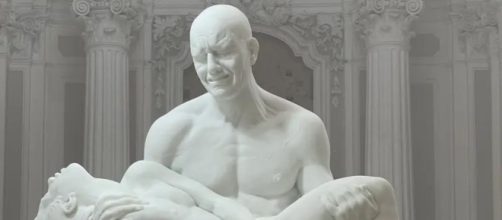Variations on a theme are nothing new in the arts. The term is even the title of a musical composition by Joseph Haydn based on a work by Johannes Brahms.
But Haydn’s variation doesn’t make him the new Brahms any more than a sculpture of a man grieving over a dead woman called “Pieta” make the artist “the new Michelangelo.”
False identity
Yet, that’s the moniker the media has bestowed upon Jacopo Cardillo, an Italian artist also named Jago. The Guardian’s headline tells the story: “Italy’s ‘new Michelangelo’ bringing sculpture into 21st century.” This is nonsense.
Putting a new spin on an old sculpture only twists the facts to make the work look good.
Jago denies the comparison to Michelangelo. He told The Guardian: “My only interest is to become the best version of myself, not the best version of someone else.” He’d have more credibility if he hadn’t taken the name of Michelangelo’s sculpture for his own.
The Pieta is a subject in Christian art. Equating a man’s sorrow over the loss of a woman with the Virgin Mary mourning the dead body of Christ makes plain Jago’s overblown dream of glory.
A distinction with a big difference
Granted, artists through time have been moved to tackle the same subjects, and not unexpectedly, with different outcomes. Apart from being different people, their times play a part.
Even in the same artist’s lifetime, styles can vary. Michelangelo’s “Pieta” is a variation of one of his earlier works. I’m thinking of his bronze relief sculpture “Mary of the Stairs,” which describes Mary holding her Infant to her chest, presumably nursing.
In contrast, Michelangelo’s “Pieta,” carved eight years after “Mary of the Stairs,” presents a different picture of motherhood with the same figures.
But the child’s pudgy fingers are now an adult’s pierced by nails. And Mary cradles her crucified Son, no longer well-fed, but wasted.
Signed and sealed
Michelangelo, who didn’t usually sign his work, carved his name across Mary’s chest. Why? When he visited the work on public display, he overheard someone ask who did the work and heard the answer “Gobo from Milan.” He thought it strange that his labors should be attributed to another.
So, one night alone with the exhibit, he chiseled his name on it.
This anecdote suggests that Michelangelo would not be happy with Jago’s version. Not that critics in the Renaissance didn’t fault his “Pieta,” saying he made Mary look too young to have an adult son.
In his defense, historian Giorgio Vasari wrote in his 1550 book "The Lives of the Most Excellent Painters, Sculptors, and Architects": "They fail to see that those who keep their virginity unspotted stay for a long time fresh and youthful."
The critics’ complaints aside, Michelangeo’s “Pieta” was the sculpture that earned him the commission for “David.” Here’s hoping “the new Michelangelo” doesn’t try to update that figure, too.


